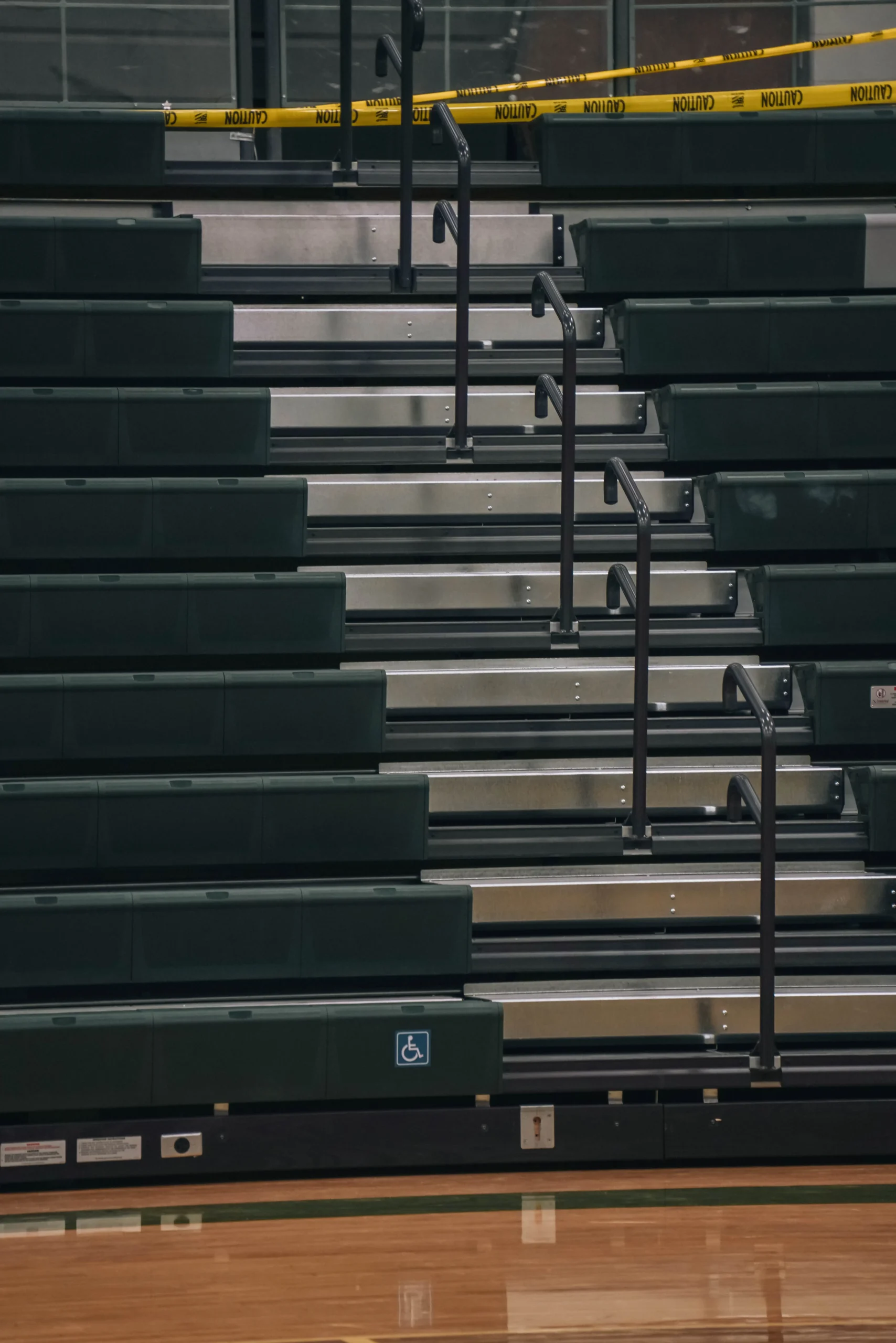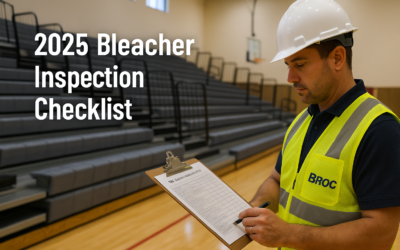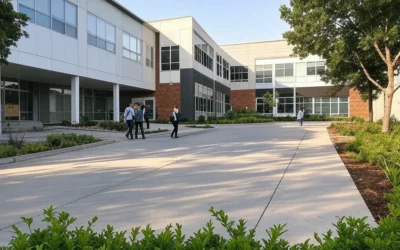Unlock a wealth of expertise with our comprehensive guide on Retractable Bleacher Troubleshooting Tips. Discover practical techniques and elevate your maintenance skills to ensure seamless operation. Dive in now!
Retractable bleachers are a popular seating option for stadiums, gymnasiums, and auditoriums. They offer flexibility and convenience, allowing for easy adjustment of seating capacity. However, like any mechanical system, retractable bleachers can sometimes encounter issues that affect their ability to retract properly. This comprehensive guide will explore the common problems associated with retractable bleachers and provide troubleshooting steps to resolve them. Whether you are a facility manager, maintenance personnel, or simply interested in understanding how retractable bleachers work, this guide will equip you with the knowledge to keep your bleachers in optimal condition.
Table of Contents
- Introduction
- Understanding Retractable Bleachers
- Common Issues with Retractable Bleachers
- Problem 1: Misalignment of Rows
- Problem 2: Jammed or Stuck Rows
- Problem 3: Damaged Drive Wheels
- Problem 4: Broken or Bent Cantilever Frame Arms
- Problem 5: Loose or Missing Hardware
- Problem 6: Malfunctioning Row Locks
- Problem 7: Cracked or Damaged Seats
- Troubleshooting Steps for Retractable Bleachers
- Step 1: Visual Inspection
- Step 2: Cleaning and Maintenance
- Step 3: Lubrication of Moving Parts
- Step 4: Proper Usage and User Education
- Step 5: Professional Assistance
- Preventative Maintenance Tips for Retractable Bleachers
- Tip 1: Regular Cleaning and Inspection
- Tip 2: Addressing Issues Promptly
- Tip 3: Educating Users on Proper Usage
- Tip 4: Implementing a Maintenance Schedule
- Safety Considerations for Retractable Bleachers
- Safety Measure 1: Warning Signs and Labels
- Safety Measure 2: Secure Access Control
- Safety Measure 3: Regular Safety Audits
- Safety Measure 4: Training and Education
- Benefits of Proper Maintenance for Retractable Bleachers
- Benefit 1: Extended Lifespan
- Benefit 2: Enhanced Safety
- Benefit 3: Cost Savings
- Conclusion
- Introduction
Retractable bleachers are a versatile seating solution that allows for easy adjustment of seating capacity in various venues. They are commonly found in sports arenas, gymnasiums, auditoriums, and other facilities where flexible seating arrangements are desired. However, just like any mechanical system, retractable bleachers can experience issues that may affect their ability to retract smoothly. In this guide, we will explore the common problems associated with retractable bleachers and provide troubleshooting steps to address them effectively. By understanding these issues and implementing proper maintenance practices, you can ensure the optimal performance and longevity of your retractable bleachers.
- Understanding Retractable Bleachers
Before delving into the troubleshooting process, it is essential to have a basic understanding of how retractable bleachers work. Retractable bleachers typically consist of multiple rows of seating platforms that can be extended or retracted as needed. They are designed to maximize seating capacity while minimizing the space required when not in use. Retractable bleachers operate on a track system that allows the rows to move smoothly inwards or outwards. The movement is facilitated by drive wheels located at the bottom of each row, which enable the bleachers to retract or extend. Additionally, cantilever frame arms provide support and stability to the seating platforms. Understanding the components and mechanisms of retractable bleachers is crucial for troubleshooting and maintenance purposes.
- Common Issues with Retractable Bleachers
Retractable bleachers may encounter several common problems that can affect their retracting capabilities. Addressing these issues promptly is essential to prevent further damage and ensure the safety of users. Let’s explore some of the most prevalent issues associated with retractable bleachers.
Problem 1: Misalignment of Rows
One common issue with retractable bleachers is the misalignment of rows. This occurs when the rows do not retract or extend in a straight line, leading to difficulty in closing or opening the bleachers. Factors such as debris or obstructions on the track, damaged drive wheels, or bent cantilever frame arms can cause misalignment. Misaligned rows impede the retracting process and pose safety risks to users.
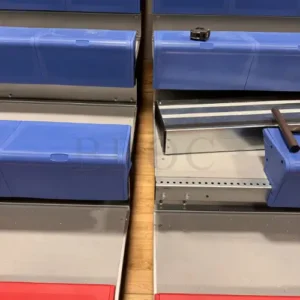
Problem 2: Jammed or Stuck Rows
Another common issue is when one or more rows become jammed or stuck during the retracting process. This can prevent the bleachers from fully retracting or extending, causing inconvenience and potential damage to the system. Jammed or stuck rows can be caused by debris, foreign objects, or mechanical malfunctions. Identifying the root cause of the jam and addressing it promptly is crucial to restore the proper functioning of the retractable bleachers.
Problem 3: Damaged Drive Wheels
The drive wheels play a crucial role in the retracting mechanism of bleachers. However, these wheels can become damaged or worn over time, leading to issues with traction and movement. Dust, debris, and improper cleaning practices can contribute to the deterioration of the drive wheels. Damaged drive wheels can result in uneven or jerky retracting, difficulty in closing or opening the bleachers, and increased wear on other components.
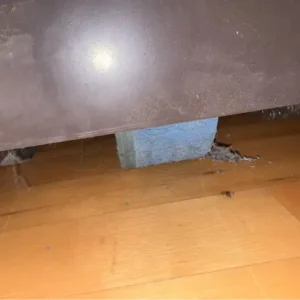
Problem 4: Broken or Bent Cantilever Frame Arms
Cantilever frame arms provide structural support and stability to retractable bleachers. When these arms become bent or broken, it can result in sagging or misaligned seating platforms. Sitting or climbing on the top tiers of the bleachers while in the closed position is a common cause of bent or broken cantilever frame arms. This misuse of the system can lead to significant damage and compromise the overall functionality of the retractable bleachers.
Problem 5: Loose or Missing Hardware
Loose or missing hardware is a common issue that can affect the overall stability and safety of retractable bleachers. Hardware such as bolts, screws, and fasteners hold various components of the bleachers together. When these hardware items become loose, damaged, or missing, it can result in instability, misalignment, or even collapse of the seating platforms. Regular inspection and maintenance of the hardware are essential to prevent further damage and ensure the safe operation of the bleachers.
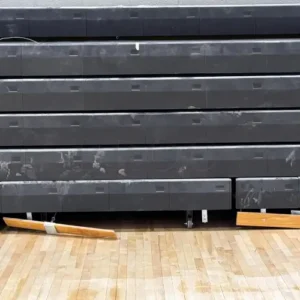
Problem 6: Malfunctioning Row Locks
Row locks play a crucial role in maintaining the proper sequence and alignment of rows in retractable bleachers. When row locks malfunction or become damaged, it can result in rows closing earlier than intended or failing to lock securely. This poses safety risks to users, as rows may shift unexpectedly during use. Tripping hazards and structural damage can occur when row locks are not functioning correctly.
Problem 7: Cracked or Damaged Seats
Seating surfaces in retractable bleachers can become cracked, damaged, or loose over time. This not only compromises the comfort and stability of the seating but also poses safety hazards to users. Sharp edges, splinters, and holes in the seats can cause injuries or accidents. Regular inspection and repair of damaged seats are essential to maintain a safe and comfortable seating environment.
In the next section, we will provide troubleshooting steps to address these common issues and ensure the optimal performance of retractable bleachers.
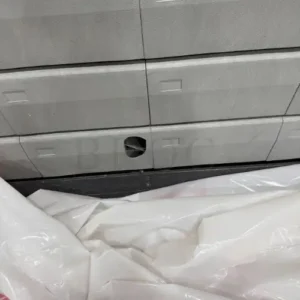
- Troubleshooting Steps for Retractable Bleachers
When faced with issues related to retractable bleachers, it is essential to follow a systematic troubleshooting approach. By identifying the root cause of the problem and implementing appropriate solutions, you can resolve the issues and restore the functionality of the bleachers. Here are the recommended troubleshooting steps for common problems encountered in retractable bleachers.
Step 1: Visual Inspection
The first step in troubleshooting retractable bleachers is to conduct a thorough visual inspection of the system. This involves visually examining all components, including the rows, drive wheels, cantilever frame arms, hardware, and seating surfaces. Look for any signs of damage, misalignment, or obstructions that may be causing the issues. Pay close attention to the bearing surface underneath the bleachers, as dust and debris accumulation can affect the retracting mechanism.
Step 2: Cleaning and Maintenance
Cleaning the retractable bleachers is an important maintenance task that can prevent issues and ensure smooth operation. Clean the bearing surface, tracks, drive wheels, and other components using a suitable cleaning solution and a soft brush or cloth. Remove any debris, dust, or other foreign objects that may hinder the retracting process. Regular cleaning and maintenance will help prevent the accumulation of dust and debris, which can lead to more severe issues over time.
Step 3: Lubrication of Moving Parts
Proper lubrication of the moving parts is crucial for the smooth operation of retractable bleachers. Apply a suitable lubricant to the drive wheels, tracks, and other areas where friction occurs. This will reduce wear and tear, enhance the traction of the drive wheels, and prevent unnecessary strain on the system. Follow the manufacturer’s recommendations for lubrication frequency and use appropriate lubricants for the specific components of your bleachers.
Step 4: Proper Usage and User Education
Educating users on the proper usage of retractable bleachers is essential to prevent misuse and potential damage. Clearly communicate the guidelines and safety measures to athletic directors, coaches, maintenance personnel, and all individuals involved in operating the bleachers. Emphasize the importance of not sitting or climbing on the top tiers while in the closed position and avoiding any actions that may cause bending or damage to the cantilever frame arms. Encourage users to report any issues or concerns promptly.
Step 5: Professional Assistance
If the troubleshooting steps mentioned above do not resolve the issues with your retractable bleachers, it may be necessary to seek professional assistance. Contact a qualified technician or an authorized service provider such as BROC with expertise in retractable bleacher systems. They will have the knowledge and experience to diagnose and address complex mechanical or structural problems. Professional assistance is particularly crucial for issues that require specialized tools or technical expertise.
By following these troubleshooting steps, you can effectively address the common issues associated with retractable bleachers and ensure their optimal performance. However, prevention is always better than cure. In the next section, we will discuss preventative maintenance tips to keep your retractable bleachers in excellent condition and minimize the occurrence of issues.
- Preventative Maintenance Tips for Retractable Bleachers
Implementing a proactive approach to maintenance is key to ensuring the longevity and optimal performance of retractable bleachers. By incorporating preventative maintenance practices into your routine, you can identify and address potential issues before they escalate, thus reducing the risk of unexpected problems and costly repairs. Here are some essential preventative maintenance tips for retractable bleachers.
Tip 1: Regular Cleaning and Inspection
Regular cleaning and inspection are fundamental to the maintenance of retractable bleachers. Establish a cleaning schedule to remove dust, debris, and other contaminants from the bearing surface, tracks, drive wheels, and seating surfaces. Conduct routine inspections to identify any signs of damage or wear. This includes checking for misalignment, loose hardware, damaged seats, and other issues that may affect the performance and safety of the bleachers.
Tip 2: Addressing Issues Promptly
Promptly addressing any identified issues or concerns is crucial to prevent further damage and ensure the safe operation of retractable bleachers. Develop a system for reporting and documenting issues and establish procedures for timely repairs or maintenance. Regular communication with maintenance personnel, facility managers, and users can help identify potential problems and expedite resolution.
Tip 3: Educating Users on Proper Usage
User education plays a vital role in the preventative maintenance of retractable bleachers. Provide comprehensive training to athletic directors, coaches, maintenance personnel, and other individuals operating and using the bleachers. Ensure they know the proper usage guidelines, safety measures, and the importance of promptly reporting any issues. Encourage a culture of responsibility and accountability among users to minimize the risk of misuse or damage.
Tip 4: Implementing a Maintenance Schedule
Developing a maintenance schedule is essential for the proactive upkeep of retractable bleachers. Establish regular intervals for cleaning, lubrication, and inspection tasks. Follow the manufacturer’s recommendations and industry best practices when determining the frequency of maintenance activities. Incorporate these tasks into your facility’s overall maintenance plan to ensure consistency and maximize the lifespan of the bleachers.
By following these preventative maintenance tips, you can minimize the occurrence of issues and maximize the lifespan of your retractable bleachers. In the next section, we will discuss the safety considerations associated with retractable bleachers and the measures you can take to ensure a safe seating environment.
- Safety Considerations for Retractable Bleachers
Safety is of paramount importance when it comes to retractable bleachers. Providing a safe seating environment for users is essential to prevent accidents, injuries, and potential liability. This section will explore key safety considerations for retractable bleachers and discuss the measures you can implement to enhance safety.
Safety Measure 1: Warning Signs and Labels
Clear and visible warning signs and labels are crucial to communicate critical safety information to users. Display signs indicating that the bleachers should not be occupied in the fully or partially closed position. Warn against climbing, sitting, or standing on tiers other than the designated seating areas. Ensure that warning labels conform to industry standards and adhere to local safety regulations.
Safety Measure 2: Secure Access Control
Controlling access to the understructure of retractable bleachers is vital to prevent unauthorized entry and potential accidents. Implement secure access control measures, such as locked access hatches or gates, to restrict access to the bearing surfaces and mechanical components. This will help prevent the accumulation of dust and debris on the drive wheels and minimize the risk of damage.
Safety Measure 3: Regular Safety Audits
Conduct regular safety audits of your retractable bleachers to ensure compliance with safety regulations and industry standards. Employ qualified professionals to assess the bleachers’ structural integrity, functionality, and safety. Address any identified safety concerns promptly and document the actions taken to demonstrate your commitment to safety.
Safety Measure 4: Training and Education
Ongoing training and education are essential to promote a safety culture among users and operators of retractable bleachers. Provide comprehensive training on safe usage, emergency procedures, and proper reporting of issues. Educate users on the potential risks associated with misuse or unauthorized bleacher access. Regularly communicate and reinforce safety guidelines to ensure a safe seating environment.
By implementing these safety measures, you can create a safer seating environment for users and minimize the risk of accidents or injuries. In the final section of this guide, we will discuss the benefits of proper maintenance for retractable bleachers.
- Benefits of Proper Maintenance for Retractable Bleachers
Proper maintenance practices have numerous benefits for retractable bleachers. In addition to ensuring their optimal performance and safety, maintenance can extend the lifespan of the bleachers and save costs in the long run. Let’s explore some of the key benefits of proper maintenance for retractable bleachers.
Benefit 1: Extended Lifespan
Regular maintenance can significantly extend the lifespan of retractable bleachers. By addressing issues promptly, cleaning and lubricating components, and conducting routine inspections, you can prevent premature wear and tear. Proper maintenance helps preserve the integrity of the structural components, reduces the risk of major breakdowns, and ensures that the bleachers remain in good working condition for years to come.
Benefit 2: Enhanced Safety
Proactive maintenance contributes to a safer seating environment. By addressing safety concerns promptly, conducting regular safety audits, and implementing preventative measures, you can minimize the risk of accidents and injuries. Well-maintained retractable bleachers provide users with a secure and reliable seating experience, enhancing their overall safety and satisfaction.
Benefit 3: Cost Savings
Investing in regular maintenance can result in long-term cost savings. By detecting and addressing issues early on, you can prevent more extensive damage that may require costly repairs or component replacements. Proactive maintenance practices also minimize the risk of unexpected breakdowns, which can lead to additional expenses and disruption of events. Proper maintenance contributes to the efficient and reliable operation of retractable bleachers, ultimately saving you time and money.
- Conclusion
Retractable bleachers offer versatility and convenience in various seating environments. However, it is essential to address common issues promptly and implement preventative maintenance practices to ensure their optimal performance and safety. By following the troubleshooting steps, conducting regular inspections, and educating users on proper usage, you can effectively address issues and extend the lifespan of your retractable bleachers. Implementing safety measures and establishing a proactive maintenance schedule contribute to a safe and reliable seating environment. Through proper maintenance, you can enhance the longevity, safety, and cost-effectiveness of your retractable bleachers, ensuring a positive experience for users and facility managers alike.

